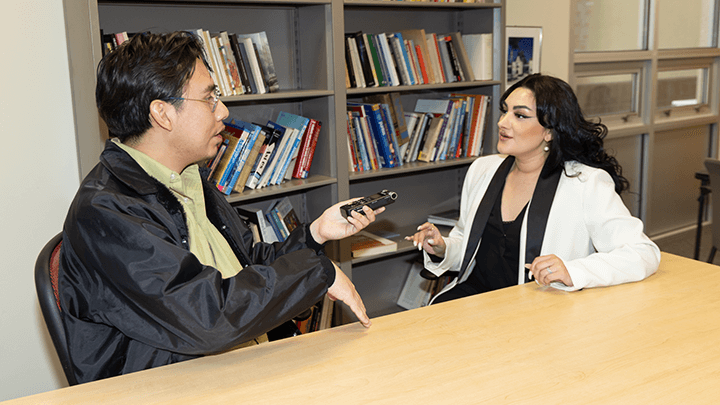Language in the borderlands: documenting the lived experiences of Spanish speakers in San Diego
Lauren Schmidt’s research highlights the ties between language and identity in local Spanish-English bilingualism

“Ethnic identity is twin skin to linguistic identity. I am my language.”
— “Borderlands: The New Mestiza” by Gloria Anzaldua
San Diego exists in an in-between space, landing on the border of California and Tijuana, Mexico. Here, in the borderlands, the concentration and variety of Spanish speakers forms its own unique culture. It is this culture, with its lived experiences and identities, that Lauren Schmidt and her colleagues have chosen to explore.
Schmidt obtained her bachelor’s degree in Spanish and anthropology from the University of Florida. Although she spoke minimal Spanish, she found her way to Hispanic studies through linguistics, where she was captivated by its balance between structure-based analytics and human-based culture. Schmidt continued her studies in the University of Florida’s master's program in Hispanic linguistics, completing her doctorate work at Indiana University in the same field. Now a part of the Spanish and Portuguese Languages and Literatures Department at San Diego State University (SDSU), she is settled in her position as an associate professor of Spanish linguistics and a graduate advisor of the Spanish master's program.
Schmidt specializes in second language acquisition and sociolinguistics, which has driven her past research on how second language learners acquire social meanings of language. However, she recently shifted gears to explore and document the lived language perspectives of Spanish speakers in the San Diego borderlands. Schmidt has teamed up with colleagues Alfredo Urzúa Beltran and Rosalva Alamillo to conduct this research, compiling a corpus — or collection of spoken texts — through their shared sociolinguistic lens and unique specialized perspectives.
After receiving seed grant funding from the university in 2023, the team hired five undergraduate students and began assembling a pilot corpus. This process involved training the students in the ethics of human-based research, such as requesting informed consent from Spanish-speaking informants. The students were also trained in how to use the microphone and recording equipment to ensure successful data collection.
The undergraduate researchers were responsible for conducting 28 oral interviews with recruited members of their respective social networks. During the interviews, a questionnaire guided the discussion through topics such as family life, traditions, customs, and language attitudes — the “beliefs and opinions that speakers have about different varieties or dialects of the languages they speak.” With the students' help, faculty researchers transcribed the collected audio for preliminary analysis and dissemination.
The researchers hope to carve out a publicly accessible digital space to house these oral interviews and written transcripts for further research and education. “We want to develop and launch an interactive website for researchers, educators, students, and even people in the general public to access these examples of San Diego Spanish,” Schmidt said.
Beyond the interviews and transcripts, the team plans to include educational modules on the website to provide relevant context and highlight important findings. With the ultimate goal of community-based research, the team intends to gather more than one hundred transcripted interviews with local Spanish speakers.
Although their data collection is far from complete, Schmidt and her colleagues have already made interesting discoveries in their research. Many of their findings come from the language attitudes section of the interviews, revealing patterns about how Spanish speakers in the borderlands view both themselves and their language.
“Many San Diego bilinguals see Spanglish, or code-switching, as a natural and even positive part of border culture and identity. We see that bilingualism is central to the self-concepts of some individuals. For many, language use is not just practical but is core to how they see themselves, how they navigate different social spaces, and how they affirm or resist different cultural belonging,” Schmidt said.
The research team presented their insights at the 1st Symposium on Spanish English Bilingualism in California and the 29th Conference of Spanish in the United States. Additionally, their work will be featured as a chapter in the upcoming publication, “Linguistic Outcomes of Spanish English Bilingualism in California.”
Despite the success of the pilot corpus, the team is facing financial and technical challenges to their continued research. Namely and most predominantly, their next phase relies on student involvement through volunteering or programs like the SDSU Undergraduate Research Program (SURP), due to lack of external funding.
However, Schmidt is committed to their goals. With one-third of the San Diego State University student population identifying as Hispanic or Latino, she understands the potential to impact students and their surrounding communities with this important work.
“Providing an academic source of the language they speak really legitimizes the varieties of Spanish and English spoken here, which can often be devalued or misunderstood,” Schmidt said. For many, their language is inseparable from their culture, making it a core feature of their ethnic and overall identities. This research provides an opportunity to legitimize not only their language but their identity as well.
Schmidt and her colleagues are “combating stigma and promoting linguistic pride” to address linguistic discrimination of those living in San Diego’s borderland region.
